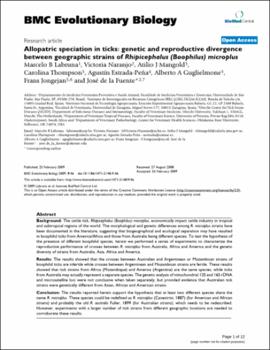| dc.contributor.author | Labruna, Marcelo B. | |
| dc.contributor.author | Naranjo, Victoria | |
| dc.contributor.author | Mangold, Atilio J. | |
| dc.contributor.author | Thompson, Carolina | |
| dc.contributor.author | Estrada-Pena, Agustin | |
| dc.contributor.author | Guglielmone, Alberto A. | |
| dc.contributor.author | Jongejan, Frans | |
| dc.contributor.author | de la Fuente, Jose | |
| dc.date.accessioned | 2018-11-09T21:10:47Z | |
| dc.date.available | 2018-11-09T21:10:47Z | |
| dc.date.issued | 2009-02-25 | |
| dc.identifier | oksd_labruna_allopatricspeci_2009 | |
| dc.identifier.citation | Labruna, M. B., Naranjo, V., Mangold, A. J., Thompson, C., Estrada-Pena, A., Guglielmone, A. A., ... de la Fuente, J. (2009). Allopatric speciation in ticks: Genetic and reproductive divergence between geographic strains of Rhipicephalus (Boophilus) microplus. BMC Evolutionary Biology, 9, Article 46. https://doi.org/10.1186/1471-2148-9-46 | |
| dc.identifier.uri | https://hdl.handle.net/11244/302056 | |
| dc.description.abstract | Background: The cattle tick, Rhipicephalus (Boophilus) microplus, economically impact cattle industry in tropical and subtropical regions of the world. The morphological and genetic differences among R. microplus strains have been documented in the literature, suggesting that biogeographical and ecological separation may have resulted in boophilid ticks from America/Africa and those from Australia being different species. To test the hypothesis of the presence of different boophilid species, herein we performed a series of experiments to characterize the reproductive performance of crosses between R. microplus from Australia, Africa and America and the genetic diversity of strains from Australia, Asia, Africa and America. | |
| dc.description.abstract | Results: The results showed that the crosses between Australian and Argentinean or Mozambican strains of boophilid ticks are infertile while crosses between Argentinean and Mozambican strains are fertile. These results showed that tick strains from Africa (Mozambique) and America (Argentina) are the same species, while ticks from Australia may actually represent a separate species. The genetic analysis of mitochondrial 12S and 16S rDNA and microsatellite loci were not conclusive when taken separately, but provided evidence that Australian tick strains were genetically different from Asian, African and American strains. | |
| dc.description.abstract | Conclusion: The results reported herein support the hypothesis that at least two different species share the name R. microplus. These species could be redefined as R. microplus (Canestrini, 1887) (for American and African strains) and probably the old R. australis Fuller, 1899 (for Australian strains), which needs to be redescribed. However, experiments with a larger number of tick strains from different geographic locations are needed to corroborate these results. | |
| dc.format | application/pdf | |
| dc.language | en_US | |
| dc.publisher | BioMed Central | |
| dc.rights | This material has been previously published. In the Oklahoma State University Library's institutional repository this version is made available through the open access principles and the terms of agreement/consent between the author(s) and the publisher. The permission policy on the use, reproduction or distribution of the material falls under fair use for educational, scholarship, and research purposes. Contact Digital Resources and Discovery Services at lib-dls@okstate.edu or 405-744-9161 for further information. | |
| dc.title | Allopatric speciation in ticks: Genetic and reproductive divergence between geographic strains of Rhipicephalus (Boophilus) microplus | |
| osu.filename | oksd_labruna_allopatricspeci_2009.pdf | |
| dc.description.peerreview | Peer reviewed | |
| dc.identifier.doi | 10.1186/1471-2148-9-46 | |
| dc.description.department | Veterinary Pathobiology | |
| dc.type.genre | Article | |
| dc.type.material | Text | |
| dc.subject.keywords | engorge female | |
| dc.subject.keywords | transmission ratio distortion | |
| dc.subject.keywords | african strain | |
| dc.subject.keywords | engorge nymph | |
| dc.subject.keywords | australian strain | |
